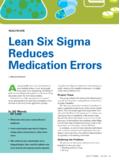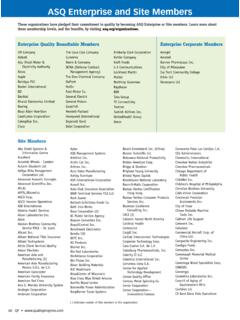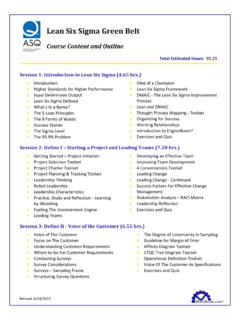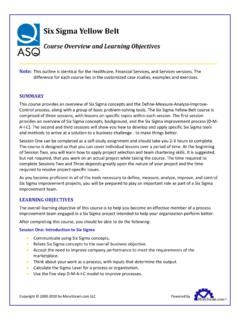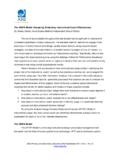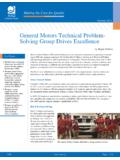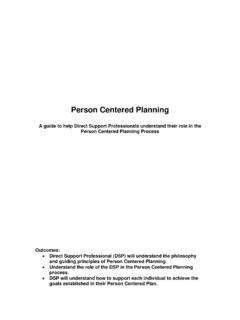Transcription of Eliminating Waste in Healthcare
1 ASQ's Healthcare Update: published in collaboration with the ASQ Healthcare Division Eliminating Waste in Healthcare Strategies to improve outcomes and reduce costs by Ellen Martin Editor's note: Awarded the 2014 Nightingale Scholarship by the ASQ Healthcare Division. The United States spends more on Healthcare than any other country in the world, yet higher spending has not resulted in better health. The most immediate opportunity for reducing Healthcare costs is to eliminate Waste , currently estimated to account for one-third of Healthcare Waste is defined as Healthcare services that do not add value or improve patient outcomes.
2 Healthcare professionals are ethically obligated to provide the best care possible to individual patients and their families. At the same time, they must be good stewards of finite resources for future health There are many causes of Waste in Healthcare , and an analysis of all potential improvement strategies is beyond the scope of this essay. The purpose of this paper is to explore two categories of Waste that are influenced by clinical practice patterns . overtreatment and failure of care coordination and describe promising strategies that have the potential to reduce wasteful spending and improve health outcomes simultaneously.
3 Part one: the toll of overtreatment Overtreatment costs the Healthcare system an estimated $192 billion per Also known as overutilization or overuse, this issue affects millions of patients and is defined as the provision of treatments that provide zero or negligible benefit to patients and potentially exposes them to risk of harm. 4 Eliminating overtreatment represents the quickest route to July 2014. ASQ Healthcare Update ASQ's Healthcare Update: published in collaboration with the ASQ Healthcare Division improved care at lower Complex, interrelated factors contribute to overtreatment, including: social expectations of physician-patient interactions, misaligned financial incentives and a medical culture prone to do more.
4 Overtreatment poses a risk to patients who may be harmed by tests or treatments, such as radiation exposure from diagnostic testing or procedural complications. Treatments such as chemotherapy in advanced cancer may be burdensome to patients, negatively impact their quality of life and have little beneficial effect on Some Healthcare professionals maintain that overutilization is caused by patient factors, such as expectations and direct-to-consumer medical marketing. One well- documented example involves the overuse of antibiotics.
5 It is common in the United States for people with colds to see their doctors to obtain antibiotics. Recent news coverage highlights the growing public health threat from antimicrobial resistance to a number of drugs. Despite the fact that physicians are aware of antibiotic overuse, physicians frequently feel compelled to satisfy patient expectations and accommodate requests for This situation illustrates the complex interaction of cultural norms and financial incentives. Patients and families expect that when an ill person goes to the doctor, the physician will provide something to improve the condition.
6 Financial incentives also influence physician practice. Physician revenue depends on seeing as many office patients as possible. From a productivity perspective, it takes longer to explain why an antibiotic is not recommended than it takes to write a prescription. One promising strategy to reduce overtreatment is the Choosing Wisely campaign, initiated by the American Board of Internal Medicine Foundation. This program was designed to facilitate dialogue between patients and physicians about Healthcare choices.
7 medical July 2014. ASQ Healthcare Update ASQ's Healthcare Update: published in collaboration with the ASQ Healthcare Division societies were challenged to identify five tests or procedures commonly overused in that specialty. This top-five list was described as a prescription for quickly saving money in that specialty while still maintaining high-quality The lists are designed as a frameworks to support individualized decision making born of conversations between physicians and patients and are used as needed based on each patient's unique circumstances.
8 Physician leadership in decreasing overutilization demonstrates concern for patient care and ensures that future Waste -reduction efforts are focused on the best interests of patients. Part two: uncoordinated care Another Waste is the failure of care coordination, a common cause of emergency room visits and hospital readmissions. One in five discharged Medicare beneficiaries are rehospitalized within 30 days of hospital discharge. Unplanned rehospitalizations are estimated to cost the Medicare program $ billion each Since the advent of hospitalist programs in the late 1990s, primary care physicians are no longer involved in the care of their hospitalized patients and may not even be notified when one of their patients is hospitalized.
9 Although inpatient and outpatient records are often exchanged, frequently, there are delays. Family caregivers are often asked to provide medical history and are expected to assume the roles of care coordinators and patient Failure of care coordination may result in duplicate diagnostic testing, medication errors and frustration among patients and caregivers. The caregiver experience of navigating care transitions was eloquently summarized by a Healthcare professional who cared for an ill spouse: How can we expect not-yet-well people to suddenly begin managing all of the complex medical and personal issues that, just the day before, were being handled by an entire team of trained professionals?
10 11. July 2014. ASQ Healthcare Update ASQ's Healthcare Update: published in collaboration with the ASQ Healthcare Division Many care coordination interventions have had a positive effect in bridging the gap between inpatient and outpatient care , especially during transitions from hospitals to homes. Two successful models include comprehensive discharge planning with early follow-up provided by advanced practice nurses12 and preparation for self-management and support by trained transition An innovative program to engage family caregivers in post-acute care is the Next Step in care Campaign of the United Hospital Family caregivers are vital to supporting patients after hospitalization.

